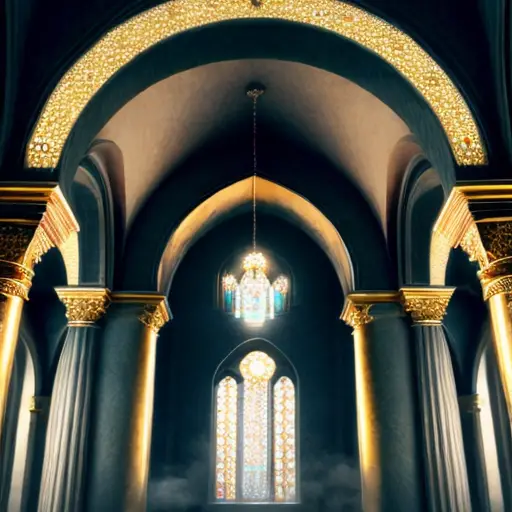Picture this: a bunch of artists sitting around, scratching their heads, wondering how to spice up their paintings. Along comes the Byzantine style, strutting in like a peacock with its vibrant colors, intricate patterns, and mesmerizing gold leaf. Suddenly, the art world is turned upside down, and artists are left in awe of this revolutionary influence on artistic expression. The Byzantine style injected a much-needed dose of pizzazz into the history of art, introducing a whole new level of opulence and grandeur. From the iconic mosaics to the majestic frescoes, this style brought forth a level of detail and richness that made even the most mundane subjects look like they were ready to conquer the world. It was like the art world had been handed a magic wand, and suddenly, everything was transformed into a dazzling masterpiece. The Byzantine style was a game-changer, leaving artists everywhere both inspired and slightly jealous that they hadn't thought of it first.
The Byzantine style introduced a unique blend of Eastern and Western artistic traditions into the history of art.
Imagine a world where art wasn't just about pretty pictures, but also about hidden meanings and secret messages. Enter Byzantine art, the master of pioneering iconography and symbolism. This style took the art world by storm, introducing a whole new level of depth and intrigue. Suddenly, every brushstroke and every color choice had a purpose, telling stories and conveying religious or political messages. Byzantine artists were like magicians, using their brushes to create a visual language that spoke directly to the viewer's soul. From the enigmatic figures in religious icons to the intricate details in mosaic masterpieces, Byzantine art brought a whole new level of intellectual stimulation to the history of art. It was like a secret code waiting to be deciphered, leaving art enthusiasts both fascinated and eager to unravel its mysteries. The Byzantine style truly revolutionized the way we perceive and interpret art, forever leaving its mark on the artistic landscape.

In the realm of art, innovation is the name of the game. And when it comes to the Byzantine aesthetic, innovation was taken to a whole new level. This style not only transformed artistic techniques but also revolutionized the materials used in creating masterpieces. The Byzantine artists were like alchemists, turning simple pigments and humble materials into works of art that exuded opulence and grandeur. They introduced a whole new range of colors, from vibrant blues and rich reds to shimmering gold leaf that seemed to dance in the light. This infusion of new materials brought a level of richness and depth to the history of art that had never been seen before.
But it wasn't just about the materials; the Byzantine aesthetic also introduced groundbreaking techniques that pushed the boundaries of artistic expression. One of the most notable techniques was the use of mosaics, where tiny pieces of colored glass or stone were meticulously arranged to create breathtaking images. This technique allowed for intricate details and a sense of permanence that captivated viewers for centuries. The Byzantine artists also mastered the art of frescoes, painting directly onto wet plaster to create vibrant and long-lasting murals. These techniques not only showcased the skill and craftsmanship of the artists but also elevated the art form to new heights.
The Byzantine aesthetic didn't stop at materials and techniques; it also brought forth a new approach to composition and subject matter. The artists embraced a sense of symmetry and balance, creating harmonious and visually pleasing compositions. They often depicted religious figures and scenes, using their art to convey spiritual messages and inspire devotion. The Byzantine style introduced a level of spirituality and reverence into the history of art, making it more than just a visual experience but also a deeply emotional and spiritual one.
In essence, the Byzantine aesthetic transformed the art world by introducing new materials, innovative techniques, and a spiritual depth that had a lasting impact on artistic expression. It elevated art from mere decoration to a powerful medium for storytelling, symbolism, and devotion. The Byzantine artists were true pioneers, leaving behind a legacy that continues to inspire and captivate artists and art enthusiasts to this day.
A fun fact about the Byzantine style is that it introduced a unique artistic feature known as 'gold ground' into the history of art. This technique involved covering the background of religious icons and mosaics with gold leaf, creating a dazzling and radiant effect. The use of gold ground not only added a sense of divine splendor to the artwork but also symbolized the heavenly realm, emphasizing the spiritual significance of the subjects depicted.
The Byzantine legacy in the realm of art is nothing short of monumental. This influential style not only introduced new techniques, materials, and aesthetics but also shaped the course of art history itself. The Byzantine artists pushed the boundaries of artistic expression, paving the way for future generations of artists to explore new possibilities. Their emphasis on symbolism, intricate details, and spiritual depth laid the foundation for the development of various art movements throughout history. From the Renaissance to the Baroque period, echoes of the Byzantine style can be seen in the works of renowned artists who drew inspiration from its opulence and grandeur. The Byzantine legacy is a testament to the enduring impact of this revolutionary style, forever leaving its mark on the artistic landscape and inspiring artists for centuries to come.